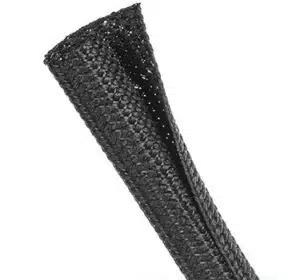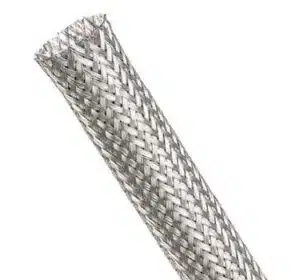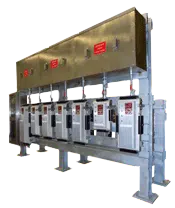TABLE OF CONTENTS



Non-Metallic Shielding
- Introduction
- Importance of Shielding Low Voltage Control Cables
- Shielding Materials and Types
- Shielding Low Voltage Control Cables in Medium Voltage Switchgear
- Overview of Low Voltage Switchgear
- Conclusion
- References
Introduction
Switchgear is an essential component of power systems, used to control, protect, and isolate electrical equipment. It can be classified into two main categories: medium voltage (MV) switchgear, typically rated between 1 kV and 52 kV, and low voltage (LV) switchgear, rated below 1 kV. In this blog, we will discuss the importance of shielding low-voltage control cables within medium-voltage switchgear, the materials required for different voltage classes, and the applicable standards and codes. We will also touch upon the basics of low-voltage switchgear.Importance of Shielding Low Voltage Control Cables
Shielding low-voltage control cables in medium-voltage switchgear is critical for several reasons:- Electromagnetic Interference (EMI): MV switchgear can generate significant electromagnetic fields that may couple with adjacent LV control cables. This coupling may cause erratic behavior or even malfunctioning of sensitive electronic devices connected to the control circuit.
- Safety: Shielding helps to protect personnel from the hazards of electric shock and arc flash. It also prevents accidental contact between the high-voltage conductors and the low-voltage control cables.
- Noise Reduction: Proper shielding can reduce noise levels in the control circuit, improving the performance and reliability of electronic devices.
- Signal Integrity: Shielding maintains signal integrity by reducing the effects of EMI on the control cables, ensuring accurate communication between devices.
Shielding Materials and Types
There are various shielding materials available for low-voltage control cables, each offering unique benefits depending on the application and voltage class:
Metallic Shielding
- Copper (Cu): Copper is an excellent conductor of electricity and is widely used for shielding purposes. It offers high EMI protection and is compatible with a wide range of insulation materials.
- Aluminum (Al): Aluminum is lighter than copper and offers good EMI protection. It is more cost-effective than copper but may not provide the same level of shielding effectiveness.
- Tin-Plated Copper: Tin-plated copper combines the benefits of both copper and tin, offering excellent EMI protection and corrosion resistance.
- Plastic non-metallic: This braided sleeving can only be used for wrapping LV control wire to shield it from voltages 5KV and below. Above 5kV must be metallic shielding.
- Foil Shields: A thin layer of metallic foil, typically aluminum or copper, wrapped around the cable insulation. Foil shields offer 100% coverage and excellent EMI protection, but they may be less flexible than other shielding types.
- Braided Shields: Braided shields consist of small strands of conductive material, typically copper or tin-plated copper, woven together to form a mesh around the cable insulation. Braided shields offer good flexibility and mechanical strength but may not provide complete coverage.
- Spiral Shields: Spiral shields are made of conductive wires wrapped helically around the cable insulation. They offer better flexibility than braided shields but may not provide complete coverage.
- Combination Shields: Combining two or more shielding types (e.g., foil and braid) can provide improved EMI protection and mechanical strength.
Shielding Low Voltage Control Cables in Medium Voltage Switchgear
Key Considerations
When shielding low-voltage control cables in medium-voltage switchgear, several key factors must be considered:- Voltage Class: The voltage class of the medium voltage switchgear will determine the required shielding effectiveness and materials. Higher voltage classes will generally require more robust shielding solutions.
- Cable Routing: Proper cable routing can minimize the coupling between medium voltage conductors and low voltage control cables. It is essential to maintain an adequate distance between the cables and use separate cable trays or conduits when possible.
- Grounding: Effective grounding of the shielding is crucial to ensure proper EMI protection. Shields must be grounded at both ends to create a low-impedance path for the noise currents to flow to the ground.
- Termination: Shielded cables must be terminated correctly to maintain the effectiveness of the shield. Ensure that proper connectors and cable glands are used, and avoid gaps or discontinuities in the shielding.
Shielding Standards and Codes
Several standards and codes govern the shielding of low-voltage control cables in medium-voltage switchgear:- IEC 61850: The International Electrotechnical Commission (IEC) standard 61850 covers communication networks and systems for power utility automation. It provides guidelines for EMI protection, cable routing, and grounding in switchgear installations.
- IEEE 1613: The Institute of Electrical and Electronics Engineers (IEEE) standard 1613 specifies the EMI immunity requirements for communication and control equipment in electric power substations. It provides test methods and performance criteria for evaluating the effectiveness of cable shielding.
- NEC (NFPA 70): The National Electrical Code (NEC), published by the National Fire Protection Association (NFPA), provides guidelines for the installation of electrical conductors and equipment in the United States. Article 300 of the NEC covers wiring methods, including shielding and grounding of control cables.
- EN 50288: The European standard EN 50288 specifies the requirements for multicore and multipair cables used in instrumentation and control applications. It includes guidelines for shielding materials, construction, and performance.
Shielding Techniques
When shielding low-voltage control cables in medium-voltage switchgear, consider the following techniques:- Use shielded cables: Selecting shielded cables with appropriate shielding materials and configurations is the first step in ensuring effective EMI protection. Ensure that the shielding material and type meet the requirements of the specific voltage class and application.
- Route cables correctly: Maintain a safe distance between the medium voltage conductors and the low voltage control cables. Use separate cable trays or conduits, and avoid running control cables parallel to power cables.
- Ground the shield: Proper grounding of the shielding is essential for EMI protection. Ground the shield at both ends to create a low-impedance path for noise currents to flow to the ground. Make sure to follow the grounding practices specified in the applicable standards and codes.
- Terminate shields correctly: Use proper connectors and cable glands to terminate the shielded cables. Ensure that the shielding is continuous throughout the entire cable length, and avoid gaps or discontinuities in the shielding.
Overview of Low Voltage Switchgear
Low voltage switchgear refers to electrical switchgear rated below 1 kV. It is commonly used in commercial, industrial, and residential settings to protect, control, and distribute electrical power. Low voltage switchgear typically includes circuit breakers, switches, fuses, and other protective devices, as well as control and monitoring equipment. Similar to medium voltage switchgear, shielding low voltage control cables is important in low voltage switchgear applications to prevent EMI-related issues, maintain signal integrity, and ensure the proper functioning of electronic devices. The same shielding materials, types, and techniques discussed for medium-voltage switchgear can be applied to low-voltage switchgear as well. However, since the voltage levels are lower, the intensity of EMI is generally less severe, and the shielding requirements may be less stringent. Nevertheless, it is essential to follow the applicable standards and codes when implementing shielding in low-voltage switchgear applications.Conclusion
Shielding low-voltage control cables in medium-voltage switchgear is critical for ensuring the proper functioning of electronic devices, maintaining signal integrity, and reducing the risk of electrical hazards. Appropriate shielding materials, types, and techniques must be used according to the specific voltage class and application requirements. It is essential to follow the guidelines provided by international and national standards and codes, such as IEC 61850, IEEE 1613, NEC, and EN 50288. In addition to medium voltage switchgear, shielding low voltage control cables is also important in low voltage switchgear applications. Although the EMI levels may be lower, proper shielding practices should still be followed to ensure the reliable operation of control and monitoring equipment.REFERENCES
- International Electrotechnical Commission (IEC). (2021). IEC 61850: Communication networks and systems for power utility automation. Retrieved from https://webstore.iec.ch/publication/62350
- Institute of Electrical and Electronics Engineers (IEEE). (2021). IEEE 1613: Standard environmental and testing requirements for communication networking devices in electric power substations. Retrieved from https://standards.ieee.org/standard/1613-2009.html
- National Fire Protection Association (NFPA). (2021). NFPA 70: National Electrical Code (NEC). Retrieved from https://www.nfpa.org/codes-and-standards/all-codes-and-standards/list-of-codes-and-standards/detail?code=70
- European Committee for Electrotechnical Standardization (CENELEC). (2021). EN 50288: Multi-element metallic cables used in analogue and digital communication and control. Retrieved from https://standards.cen.eu/dyn/www/f?p=204:110:0::::FSP_PROJECT,FSP_ORG_ID:40760,6052&cs=14F1177D3D89AAE1C0F1C97B7C1A8DBF9
Written by: Cole Attaway
Cole Attaway is the founder and CEO of Spike Electric Controls. Spike's mission is to improve the accessibility and delivery of industrial electrical gear for clients nationwide. Spike solutions result in reduced unplanned downtime, less overtime, and greater operational efficiencies.


